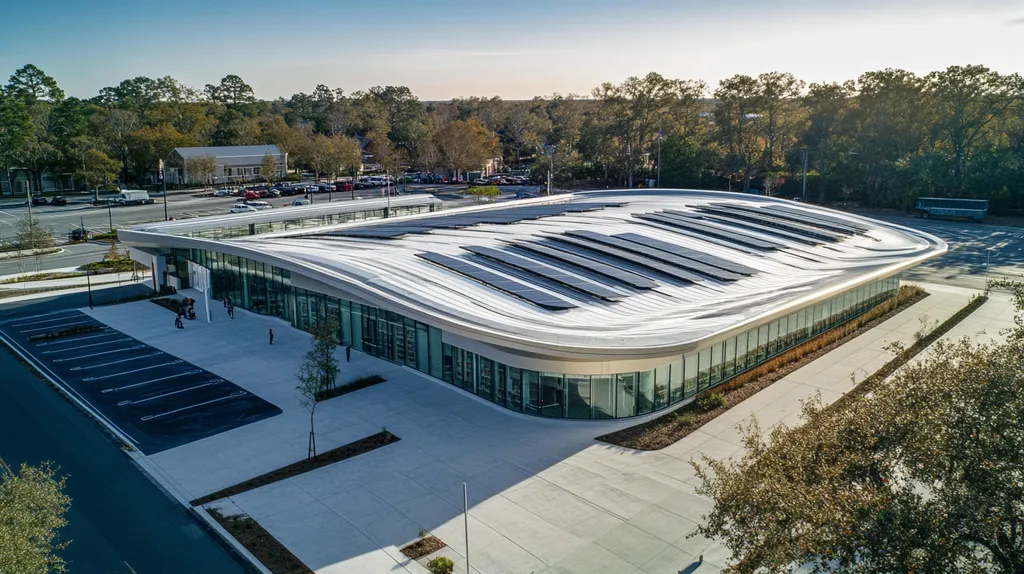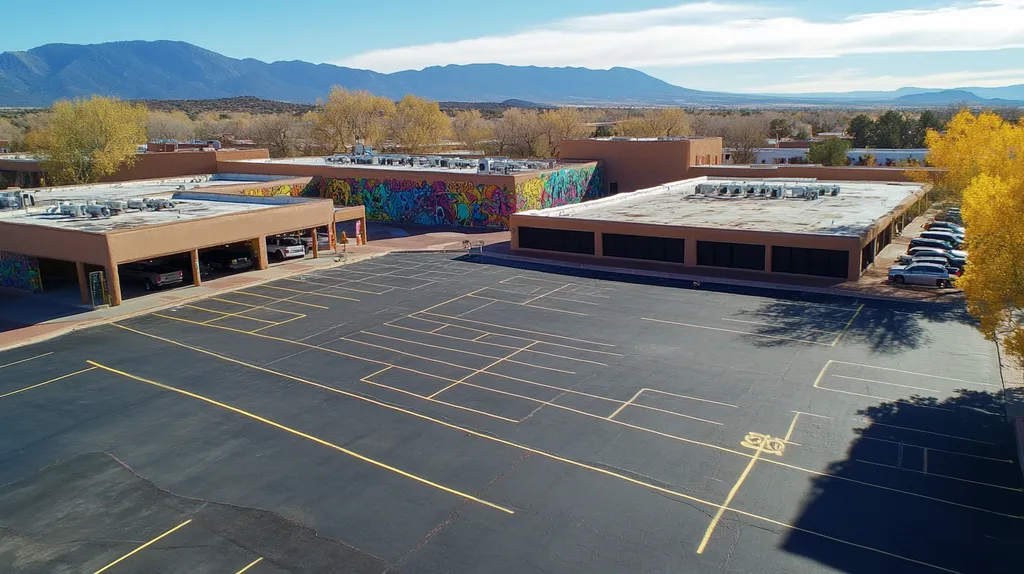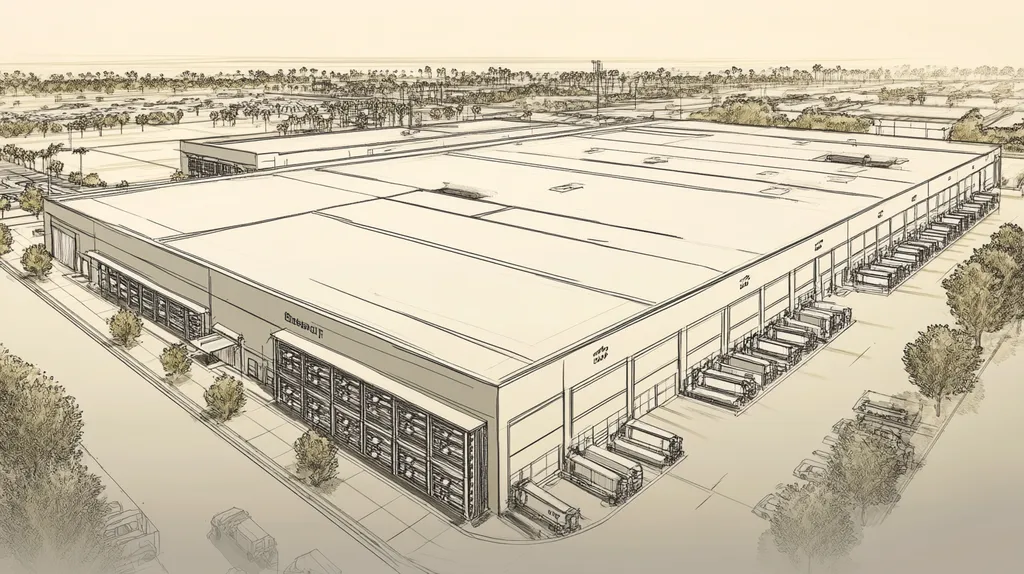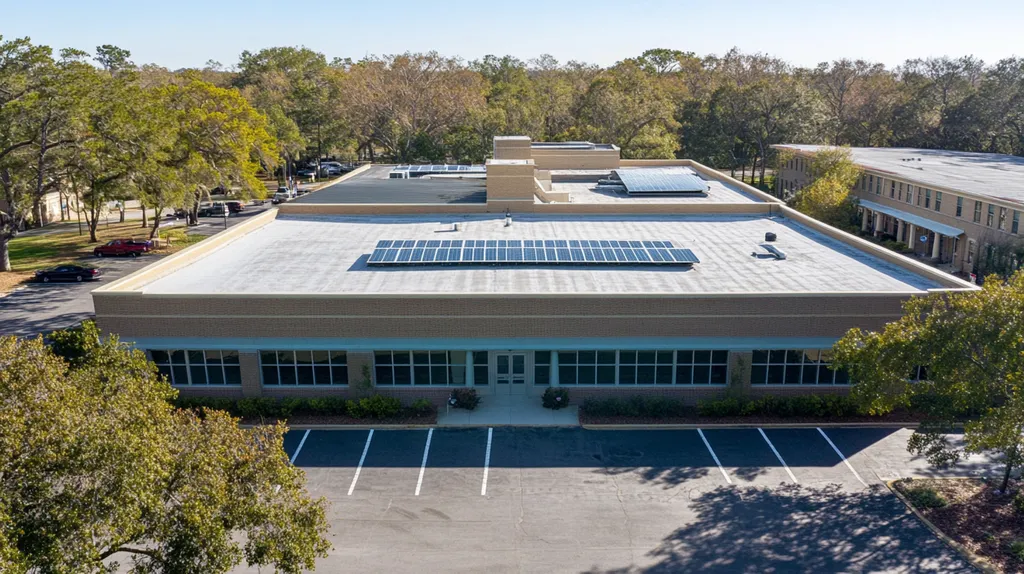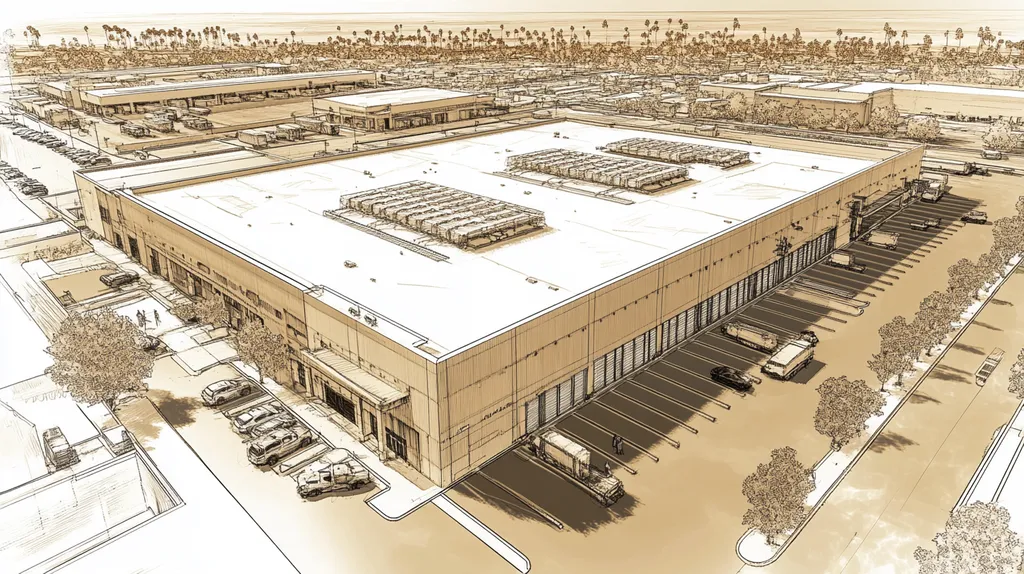As energy costs soar and building efficiency takes center stage, commercial property owners are leaving money on the table by overlooking roof coatings. Studies show these specialized applications can slash cooling costs by up to 30% while qualifying for substantial tax credits.
Yet confusion about coating types, application timing, and credit eligibility prevents many facilities from capitalizing on these benefits. The maze of technical specifications and incentive programs has created analysis paralysis.
This guide cuts through the complexity to deliver actionable insights on selecting, implementing and maintaining roof coatings while maximizing available tax advantages.
SECTION 1: THE BASICS EXPLAINED
As energy prices continue to climb and sustainability becomes more than a buzzword, understanding commercial roof coatings isn’t optional—it’s essential. These coatings can dramatically cut cooling costs and boost energy efficiency, with studies showing they can cool rooftops by as much as 50 degrees Fahrenheit. That’s not just a minor change; it’s a game-changer for building performance.
What It Is (In Plain Language)
Commercial roof coatings are highly specialized materials applied to existing roofs, turning them into energy-efficient powerhouses. By creating a reflective layer that bounces sunlight away, these coatings significantly cut down on heat absorption. Made from materials like elastomeric, acrylic, or silicone, they not only protect the roof but also enhance its thermal performance.
This additional layer extends the roof’s lifespan and helps keep indoor spaces cooler. The application process is streamlined—clean the roof, apply the coating uniformly, and voila! You’re left with a hassle-free, energy-saving solution that’s less disruptive than a full roof replacement.
Essentially, roof coatings are a wallet-friendly approach to bolster your roof’s longevity while simultaneously ramping up energy efficiency.
Why It Matters (To Your Building)
For property owners, embracing commercial roof coatings means unlocking a range of financial and environmental benefits. These coatings do more than just shield the roof—they can lead to energy savings of up to 30% on cooling costs, an enticing proposition for anyone looking to cut expenses.
Furthermore, these coatings support environmental sustainability. They help lessen the urban heat island effect, making your building a greener option for eco-conscious tenants. Plus, don’t forget the perks: various local and federal programs offer enticing tax credits for energy-efficient upgrades like roof coatings, potentially offsetting installation costs (source: ENERGY STAR).
The bottom line? Adding roof coatings is a savvy strategy for property owners aiming for improved efficiency and a more sustainable future.
How It Works
Commercial roof coatings excel due to their solar reflective properties. By bouncing back more sunlight, they minimize heat absorption, helping keep interior temperatures low. This means you can rely less on air conditioning—your utility bill will thank you.
The seamless barrier created by these coatings shields against UV damage, moisture, and the wild swings of Mother Nature. Each type of coating offers unique benefits, from flexibility to adhesion, making it crucial to pick the right one for your building.
But it doesn’t stop there; these coatings also dramatically extend the life of the roof. By decreasing the chance of leaks and structural damage, they save time and money on repairs and replacements down the line.
In summary, opting for commercial roof coatings is not just a no-brainer—it’s a powerful strategy to boost energy efficiency and protect your investment from the elements.
SECTION 2: PRACTICAL APPLICATIONS
Grasping the practical applications of commercial roof coatings is crucial for optimizing energy savings and snagging those tax benefits. Many property owners turn a blind eye to these solutions, leaving their wallets—and the planet—hanging out to dry. Research reveals that these coatings can chill roof temperatures by as much as 30 degrees, making a significant dent in energy consumption. This section dives into common uses, the optimal timing for application, and how roof coatings play nice with other systems.
Common Uses & Examples
Commercial roof coatings are a versatile tool in property maintenance, designed to serve various purposes. They shine on flat or low-slope roofs, where heat absorption is a sneaky culprit behind sky-high energy bills. For instance, a reflective coating on a massive warehouse can slash cooling costs by keeping heat at bay.
Aging roofs also benefit immensely from coatings, especially when leaks and peeling surfaces become a nuisance. These coatings can not only extend a roof’s life but save property owners from expensive repair bills. Imagine a retail center reducing energy expenses without sacrificing curb appeal—thanks to a high-performance coating, it’s a win-win.
On top of that, many coatings provide waterproofing, making them a lifesaver in areas with heavy rainfall. Their multifunctionality makes coatings an essential asset for facility managers who are looking for long-term savings without the headache of constant upkeep.
When You Need It Most
Timing is everything when it comes to applying roof coatings, affecting both energy efficiency and your budget. The sweet spot for application is during spring and early summer when the roof is clean, dry, and ready for action. By gearing up before the scorching heat kicks in, property owners can maximize the cooling advantages.
In urgent scenarios, like post-storm mayhem, a quick application can prevent further complications, like mold or structural damage, that often follow water leaks. Acting swiftly can save a facility from serious headaches down the line.
Regular roof inspections should also drive your re-coating schedule. Facilities with aging roofs nearing their twilight years are prime candidates for coatings that extend lifespan and delay those dreaded replacement costs.
Interactions With Other Systems
For roof coatings to truly shine, they need compatibility with existing roofing materials. Applying a coating over a single-ply membrane, such as TPO, boosts energy efficiency while ensuring everything plays well together. This perfect match creates a smooth energy-saving strategy.
Maintenance practices play a critical role as well. Regular cleaning and preventive care ensure that coatings adhere properly and provide the intended benefits. Facilities that adopt this proactive approach generally see enhanced energy savings and reduced costs.
Lastly, syncing roof coatings with HVAC systems is non-negotiable. A reflective coating can enhance newer cooling systems, leading to greater energy savings. Properties that leverage both strategies frequently unlock larger tax credits and lower energy bills, solidifying roof coatings as a smart move in comprehensive energy management.
SECTION 3: KEY TERMINOLOGY DECODED
Decoding the terminology surrounding commercial roof coatings is essential for property owners and facility managers alike. A strong grasp of these terms empowers informed decisions that lead to significant energy savings and unlocks eligibility for lucrative tax credits. In an industry filled with buzzwords and jargon, understanding these key concepts ensures stakeholders can confidently navigate the often-overwhelming world of roofing systems. This section breaks down essential terms, translates industry lingo, and clarifies measurement units associated with roof coatings.
Essential Terms Explained
In the realm of commercial roof coatings, terms like “reflectivity” and “emissivity” are game-changers. Reflectivity measures how much sunlight a roof reflects back into the atmosphere, while emissivity tells you how efficiently it sheds absorbed heat. Both elements are vital for maximizing energy efficiency and keeping those cooling bills in check.
Next up is the “cool roof,” a superstar in the roofing world designed to absorb less heat than your average roof. By implementing cool roofs, property owners can enjoy remarkably lower cooling costs, creating more comfortable indoor spaces and slashing overall energy consumption.
Lastly, there’s “life cycle cost” (LCC), which assesses the total expenses wrapped up in a roofing system from the moment it’s installed to the day it’s replaced. Knowing LCC helps property owners spot long-term savings, and let’s be honest, who wouldn’t want that?
Industry Jargon Translated
Terms like “LEED” (Leadership in Energy and Environmental Design) might sound intimidating, but they’re essential when discussing sustainability. LEED certification showcases a building’s commitment to energy efficiency and minimal environmental impact, something that should have property owners doing a happy dance.
Another recurring term is “thermal performance.” This describes just how well a roof can insulate against heat transfer, which is crucial for optimizing heating and cooling efforts. Higher thermal performance translates to lower energy bills—simple enough, right?
It’s also essential to grasp the meaning of “UV degradation.” This process refers to the gradual breakdown of roofing materials due to UV exposure. A good understanding of this concept can inform material choices, ensuring longevity and durability.
Measurement & Units Simplified
Understanding measurement units is key when weighing options for commercial roof coatings. The “R-value” is a crucial metric representing thermal resistance; higher R-values indicate better insulation efficiency, paving the way for impressive energy savings.
Another important term is the “Solar Reflectance Index” (SRI), which combines reflectivity and emissivity into a single score. To qualify for cool roof credits, an SRI above 78 is typically required. It’s not just numbers; it’s about saving money, too.
Lastly, property owners need to get comfortable with square footage measurements. Roofing materials are marketed based on coverage per square foot, making accurate area calculations essential for estimating costs and planning installations. Precision here can prevent budget overruns and costly surprises down the road.
SECTION 4: DECISION FACTORS
When property owners tackle the prospect of roof coatings, the stakes couldn’t be higher. The decision isn’t just about slapping on a coat of paint; it’s about making an investment that can slim energy bills and enhance property value. As energy costs climb, weighing upfront costs against long-term savings becomes crucial. Property managers must analyze not only the cash outlay but also the performance and durability of materials involved. The right decisions here can unlock valuable energy tax credits, enhancing the financial equation.
Cost Considerations
Cost is always a hot-button topic, especially when it comes to roof coatings. Sure, premium coatings may seem pricey at first, but don’t be fooled—those costs could pale in comparison to the savings on sizzling summer cooling bills. A reflective coating effectively bounces back sunlight, leading to a shorter payback period through lower utility expenses.
Also, don’t sleep on available tax credits. Various federal and state incentives can shave a hefty chunk off installation costs, transforming a once-daunting expense into an appealing investment. Property owners need to be in the know about these benefits to stretch their dollars further.
Moreover, be vigilant about hidden costs lurking in the shadows. Choosing the cheapest option might seem savvy until repair and maintenance bills start piling up. A comprehensive cost-benefit analysis helps paint a clear financial picture, revealing the true cost of ownership.
Ultimately, smart decision-making regarding costs can lead to substantial financial rewards in the long haul.
Performance Trade-offs
Performance is where roof coatings either shine or fade away. Different materials boast varying performance attributes, which can directly impact energy efficiency and resilience. Opting for a coating with a robust Solar Reflective Index (SRI) can yield impressive energy savings, but it’s vital to consider other performance metrics like adhesion and resistance to weather extremes.
Some coatings might offer stellar reflectivity but falter in durability, especially under stress. For instance, silicone coatings are champions in wet conditions, yet they may not stand up against relentless UV exposure. Evaluating these trade-offs is crucial for maintaining the integrity and performance of a property.
The local climate should also factor into the decision. A coating that excels in one region might leave you disappointed in another. Taking environmental conditions into account can maximize long-term gains.
Thorough performance evaluations lead to better decision outcomes in energy efficiency and roof longevity, ensuring that your investment remains solid for years to come.
Lifespan & Durability Factors
The lifespan of roof coatings is a game changer that can have a monumental impact on long-term expenses. Investing in high-grade materials generally extends the life of a roof, saving property owners from costly replacements down the line. With warranties typically spanning 10 to 25 years, proper maintenance can push that lifespan even further.
Durability matters too, especially in climates that throw everything from torrential downpours to blistering heat at your roof. For instance, a coating that can withstand hurricane winds is essential in storm-prone areas. Picking the right materials reduces the frequency of repairs and replacements.
Routine upkeep can significantly boost durability. Regular inspections and proactive maintenance fend off minor issues before they balloon into costly disasters. Budgeting for both installation and ongoing upkeep leads to a well-protected, efficient building.
By keeping these factors front and center, property managers can make sound decisions that enhance both the value and efficiency of their buildings.
SECTION 5: COMMON CHALLENGES
Implementing commercial roof coatings can seem like a no-brainer, but don’t let the shiny surface trick you. Common challenges like poor application, lack of proper surface prep, and limited durability can derail even the best intentions. Statistics reveal a staggering 30% of coatings fall short of their expected lifespan due to these pitfalls. Recognizing these challenges is vital for any property owner looking to maximize their investment and snag those enticing energy tax credits.
Frequent Problems & Solutions
Improper installation is the villain of the story, often causing coatings to fail prematurely. This nightmare scenario typically arises when the roof surface is not sufficiently cleaned or prepped, ruining adhesion. Solution? Hire qualified pros who know the ropes and follow the manufacturer’s guidelines like their jobs depend on it—which they do.
Next up is selecting the wrong type of coating. Not all roofs are created equal, and blood-curdling mistakes arise when unsuitable coatings are applied. A solid assessment of the current roof and local climate can steer property owners away from this fate. Consulting with roofing experts can help ensure that the right coating is chosen for optimal performance and energy efficiency.
Inadequate maintenance can also truncate a coating’s lifespan faster than you can say “budget constraints.” Regular inspections can catch issues before they mushroom into financial nightmares. Crafting a maintenance schedule that includes consistent assessments and timely touch-ups will keep the coating intact and effective.
Lastly, let’s talk budget. Going for the cheapest option can make wallets feel good today but can lead to a world of hurt tomorrow. It’s wiser to invest in high-quality coatings that may seem more expensive upfront but deliver long-term advantages through durability and energy savings.
Warning Signs To Watch For
Catching issues with roof coatings early can save property owners from suffering significant financial losses. Discoloration or fading on the surface is a major red flag indicating a coating that’s losing its grip and efficacy. Regular visual inspections can help snap these problems out of existence before they wreak havoc on energy savings.
Blistering or peeling is another sinister indicator that moisture may be having a party under the coating, which can lead to leaks. Regularly checking for these signs can be the difference between a minor fix and a full-blown repair disaster.
No one likes to see cracking or chipping in their roof coating. These issues can signal thermal stress or improper application. A semi-annual inspection ritual—especially after storms—can nip these problems in the bud.
Lastly, water pooling on the roof is a clear sign of drainage issues. Standing water not only accelerates coating deterioration but can also contribute to bigger, scarier problems. Addressing drainage promptly is crucial to preserving both the coating’s longevity and the roof’s performance.
Preventative Approaches
To ensure that commercial roof coatings stand the test of time, property owners need a proactive strategy. Start with thorough pre-installation inspections to catch any issues before they get dressed up in a shiny new coat. A clean, debris-free roof is essential for optimal adhesion.
Using high-quality materials specifically designed for your roofing type can make a world of difference. Partnering with a roofing specialist ensures you’re armed with the best info to choose products that suit your unique environment.
Adopting a regular maintenance schedule is a must. Routine cleaning and inspections allow property owners to catch minor problems before they morph into colossal headaches. Think of it as a dental checkup—preventative care today saves major costs down the line.
Education is key; staying informed on the latest technologies and best practices empowers property owners and facility managers to keep their roofing systems in check. Knowledge about emerging trends enables smarter decisions, maximizing the benefits of their roof coatings.
SECTION 6: NEXT STEPS & RESOURCES
For property owners eager to tap into the benefits of commercial roof coatings and associated energy tax credits, taking informed steps is crucial. Properties equipped with reflective roof coatings can enjoy energy savings of up to 30% annually. Engaging knowledgeable providers will play a pivotal role in realizing these savings and credits. This section outlines essential questions to pose to service providers, important industry standards to consider, and resources for ongoing education.
Questions To Ask Providers
When vetting potential roofing providers, asking the right questions is essential. Start with inquiries about their experience handling energy-efficient coatings and which specific products they recommend. Understanding the lifespan and warranty of proposed materials is crucial for calculating long-term upkeep costs.
Be sure to ask how they evaluate the existing roof condition before applying coatings. A thorough assessment is key to addressing any underlying problems, ensuring maximum benefit from the new installation. Request documentation on previous projects, particularly case studies that demonstrate energy savings achieved.
Additionally, gauge their knowledge of local energy tax credit programs. A skilled provider will guide you through these incentives, ensuring you seize all available financial benefits.
Finally, confirm whether they conduct a post-installation performance evaluation. This step helps measure real-world energy savings against initial projections, ensuring the investment pays off over time.
Industry Standards & Guidelines
Industry standards for roof coatings are designed to ensure quality and consistent performance. The Cool Roof Rating Council (CRRC) offers resources that provide ratings for reflectivity and emissivity. Opt for coatings that meet or exceed these standards to maximize energy efficiency.
The Energy Star program assesses roofing products, certifying those that meet strict energy performance criteria. Using these ratings as guidelines can help simplify your selection process when choosing coatings.
Also, familiarize yourself with local and state building codes concerning roof coatings. Compliance not only safeguards your property but can also impact eligibility for energy tax credits.
Resources from the National Roofing Contractors Association (NRCA) offer access to best practices and current guidelines within the industry. Staying informed about advancements will empower property owners to make effective and compliant roofing decisions.
Further Learning Simplified
Ongoing education about commercial roof coatings and energy-efficient technologies is vital. A plethora of resources exists to demystify these complex topics for property owners. Websites like ENERGY STAR and the Department of Energy provide webinars, guides, and articles specifically designed for decision-makers.
Professional organizations, including the NRCA, often host conferences and networking events that keep you updated on trends and best practices. Participate in these events to enhance your understanding and establish valuable connections.
Online courses and certifications covering the benefits and applications of roof coatings are also available. Investing time in these resources can significantly enhance a property owner’s ability to make informed decisions that maximize energy savings.
Lastly, local workshops frequently focus on state-specific tax incentives related to energy-efficient roofing. Engaging in these workshops can yield essential insights tailored to your property’s needs.
The Bottom Line
With energy costs projected to rise 30% over the next decade, commercial property owners can’t afford to ignore roof coatings and their associated tax benefits any longer.
Studies show that buildings implementing reflective roof coatings slash cooling costs by up to one-third while qualifying for federal tax credits covering up to 30% of installation costs.
Yet the window for maximizing these incentives grows shorter each year as programs phase out or reduce benefits.
Smart facility managers will partner with qualified providers now to evaluate their properties, implement appropriate coating solutions, and capture available tax advantages before this opportunity evaporates.
The technology is proven, the savings are documented, and the incentives are available today – but they won’t be forever.
FREQUENTLY ASKED QUESTIONS
Q. What are commercial roof coatings and why do they matter?
A. Commercial roof coatings are specialized materials applied to existing roofs to enhance energy efficiency and longevity. They create a reflective layer that minimizes heat absorption, helping lower cooling costs significantly. These coatings not only protect the roof but extend its lifespan, offering substantial financial and environmental benefits for property owners.
Q. When is the best time to apply commercial roof coatings?
A. The ideal time for applying roof coatings is during spring and early summer when the roof is clean and dry. This timing maximizes the benefits of cooling properties before the heat really kicks in. Immediate application after storms can also prevent moisture-related issues, making timely actions critical for performance.
Q. What key terms should I know about commercial roofs?
A. Understanding terms like “reflectivity” and “emissivity” is essential. Reflectivity measures sunlight reflection, while emissivity gauges heat shedding efficiency. Additionally, knowing the Solar Reflectance Index (SRI) and life cycle cost (LCC) helps assess roofing options for better energy savings and overall performance.
Q. What should I consider when deciding on coating types?
A. Cost, performance, and durability are paramount. While premium coatings can seem pricey, their energy savings often justify the upfront costs. Evaluate trade-offs: some excel in reflectivity, while others may struggle with weather extremes. Understanding your local climate plays a critical role in making the right choice.
Q. What are common challenges with roof coatings?
A. Key challenges include improper installation and inadequate surface preparation, leading to early failures. Neglecting maintenance can also shorten a coating’s lifespan. Regular inspections and hiring qualified professionals can help avoid these pitfalls, ensuring you get the most out of your investment in coatings.
Q. How can I ensure I choose the right roofing provider?
A. Ask potential providers about their experience with energy-efficient coatings and their evaluation methods for existing roofs. Look for documentation on past projects showcasing energy savings and inquire about knowledge of local tax incentives. A strong provider will guide you through the entire process.
Q. What specific maintenance should I perform on commercial roof coatings?
A. Regular inspections are crucial; check for signs of discoloration, peeling, or cracking. Ensure drainage is functioning properly to prevent water pooling. Routine cleaning and touch-ups based on inspection findings will prolong the life of your coating and maximize energy savings.

